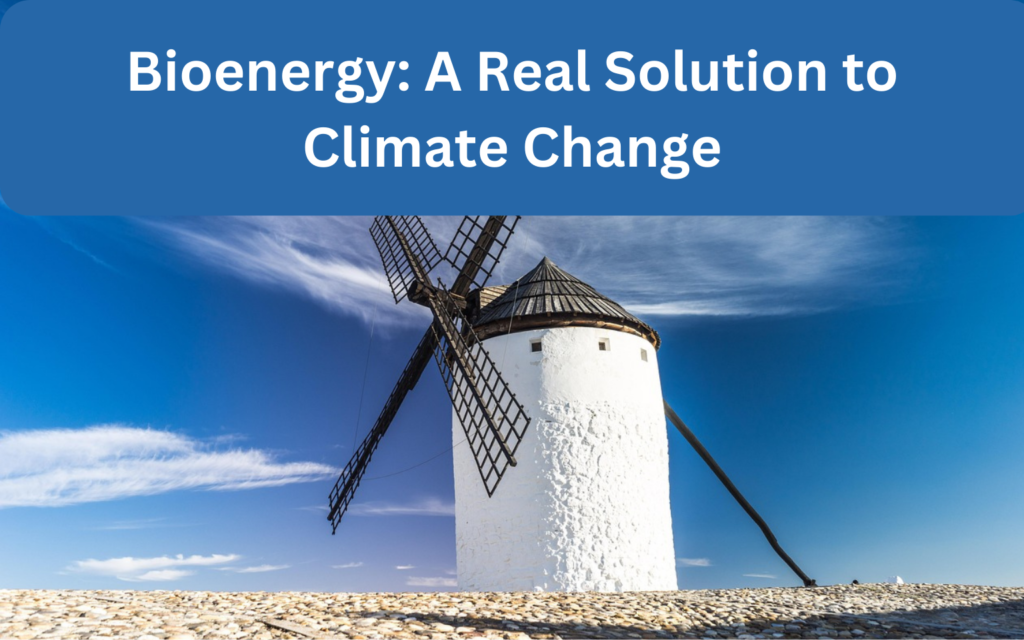Abstract
The role of bioenergy in a climate-changing world is pivotal, as it offers a sustainable and renewable source of energy derived from organic materials, such as biomass and biofuels, which not only helps reduce greenhouse gas emissions but also contributes to mitigating the adverse effects of climate change
Bioenergy has been the subject of intense scrutiny in recent years, with many countries conducting significant research to define and measure sustainable practices. This paper discusses the main challenges and policy issues related to sustainable bioenergy and provides recommendations for scaling up these approaches globally.
1.Sustainable Bioenergy Innovation
One hundred thirty-seven experts from 24 countries and 82 institutions collaborated over the past two years. Their collective effort focused on studying environmentally-friendly methods of producing bioenergy, a form of plant-based energy. The culmination of their research, titled ‘Bioenergy & Sustainability: Bridging the Gaps’ (Souza et al., 2015a), outlines their discoveries.
Presenting their findings at a meeting in Washington DC, USA on September 28, 2015, they delved into the potential of producing energy from plants without causing harm to the environment. Attendees included representatives from various research groups, governments, and organizations such as the World Bank. The discussions encompassed not only the present but also explored the prospective benefits of this plant-derived energy in 2030 and 2050
2.Bioenergy Outlook in Developing Nations
Increased energy consumption can improve human development, education, and public health. However, ensuring this growth is sustainable and does not damage the environment is essential.
There are many challenges to the development of bioenergy in developing countries. These include the need for investment in infrastructure, the availability of land and water resources, and the potential for competition with food production. However, the potential benefits of bioenergy are significant, and it is an essential option for sustainably meeting the energy needs of developing countries.
Bioenergy coupled with carbon capture and storage (BECCS) is a promising technology for mitigating climate change. BECCS can remove carbon dioxide from the atmosphere by capturing it from biomass combustion or fermentation and storing it underground.
The IPCC (Intergovernmental Panel on Climate Change) has identified BECCS as a critical technology for achieving net-zero emissions by 2050. However, some challenges must be addressed before BECCS can be widely deployed.
One challenge is the cost of BECCS. The technology is still in its early stages of development, and the prices are high.
Finally, there are environmental concerns about BECCS. Some people worry that BECCS could lead to deforestation or competition with food production.
3. Sustainable bioenergy: A pathway to food security
The top priority for a successful partnership between bioenergy and food security is efficiently combining resources to enhance the availability of both food and water. This means investing in technology, rural education, and innovations that strengthen capacity and infrastructure. Encouraging stable prices can boost local food production, and utilizing double cropping and flex crops (plants grown for both food and non-food uses) can provide food, energy, and other benefits.
Technology and better management practices obtained from previous experiences can shift concerns from risks to solutions. Predicted land needs for bioenergy are manageable within available land resources. By dedicating around 50-200 million hectares to bioenergy, we could contribute about 25% to our future energy supply.
Estimates suggest that to counteract climate change significantly, we’d need 80 to 200 exajoules (EJ) of modern bioenergy by 2050. This might require about 200 million hectares of land. Some projections suggest even more land, but experts believe advances in science-based guidance and actual crop data will lead to better predictions. Importantly, intensifying current agriculture practices is more likely than expanding agriculture into new areas.
Global food trends indicate that much land used for agriculture contributes little to food production. Even the additional cropland predicted to feed the world in 2050 (70 million hectares) is just 5% of available convertible land. Analyzing land availability, 40% of primary energy needs could come from 40% of public land, excluding certain areas.
To make this work, sustainable biomass production requires policies that support long-term investment for improving crop productivity and reaping environmental, economic, and social benefits.
4. Enabling bioenergy contributions to environmental security
The environmental impacts of bioenergy production vary depending on the specific context, such as the type of biomass used, the production methods, and the land use practices. In general, bioenergy can have both positive and negative environmental impacts.
Biofuels can have lower human health toxicity and reduce greenhouse gas emissions compared to fossil fuels.
The environmental impacts of bioenergy production can be mitigated using sustainable production methods and land use practices. For example, bioenergy production can be made more bearable using biomass from waste streams, such as wood waste or agricultural residues. It can also be made more sustainable by using improved land management practices that protect soil and water resources.
Overall, the environmental impacts of bioenergy production are complex and depend on various factors. It is essential to consider the potential ecological impacts of bioenergy production before deciding its use.
5. Making a Policy that Benefits All
We need to figure out how to tell people about the good things that come from using bioenergy. This kind of energy is clean and helpful for the environment and society. The world is changing because of pollution from fossil fuels, so it’s essential to use cleaner energy like bioenergy (you can read more about this in Box 2). We must ensure everyone understands why moving away from fossil fuels is urgent and that bioenergy can help. We can learn from communication strategies that have worked before.
In places where people didn’t have much energy, bioenergy improved things. It enhanced people’s lives, protected forests by reducing old ways of getting power, made farming better, and helped rural areas grow (as explained by Diaz-Chavez et al., 2015). There are new business opportunities, but they need better planning and organization. We must consider how much is available and necessary to make bioenergy work well globally. Sometimes, even if it wasn’t the primary goal, using bioenergy has positively helped communities. To make this happen, it’s essential to involve the affected people.
6. Challenging Low Oil Price Competition
To achieve sustainable development, it’s important to remember that short-term goals aren’t solely about competitiveness or low production costs. Building local knowledge, strong work ethics, and social benefits takes time. While market forces and making biofuels and biomass pellets more common can contribute to regional and global progress, governments and businesses need to work together to create a sustainable way to distribute these products. This is incredibly challenging for developing and developed countries as they face different obstacles. Developing nations are more vulnerable to climate change impacts, while developed countries rely heavily on global markets.
In the past, using different forms of bioenergy gained popularity mainly when they had some unique advantages, like ethanol’s high octane rating. To compete with the heavily subsidized low prices of fossil fuels (which receive over $500 billion/year in estimated support), we must factor in the costs of dealing with climate change and the harmful effects of using fossil fuels. While bioenergy can help us adapt to climate change, it requires substantial investments until the technologies are fully developed, which comes with financial risks. Similarly, investments are needed for capturing and storing carbon dioxide and improving integrated systems over the long term. Despite meeting only some of the criteria, it’s our responsibility to develop bioenergy to tackle climate change.
Science will play a significant role in finding ways to reduce the negative impacts of bioenergy production and helping with decision-making processes. We must gather information about its costs and benefits to make informed choices as bioenergy becomes more widespread. This can be done through collaborative plans that consider the landscape and supply chains, allowing stakeholders to make better decisions about where to produce bioenergy, how to transport it, and how to distribute it.
7. Bioenergy: A science-based approach to a cleaner planet
Bioenergy has been closely examined in the past decade, with many countries working to establish sustainable practices. Concerns include:
- Potential clashes with food production.
- Doubts about available land.
- The true sustainability of bioenergy.
These issues have sparked debates, causing some regions to pause their development efforts. The primary risk is a manageable rush towards harmful land-use changes, as recent declines in bioenergy investments suggest growth might slow down. Instead, the real danger is that bioenergy development could proceed too slowly. This could remove a crucial strategy for addressing climate change from the options.
Bioenergy should be an integral part of strategic plans for a low-carbon economy. Long-term policies can significantly contribute to global economic growth if long-term policies are in place. To make informed decisions and create suitable funding approaches, we must comprehend the costs and benefits of the production chain. This includes assessing social impacts, and one collaborative effort, like the partnership known as Below50, showcases sustainable fuel options that can greatly reduce carbon emissions. This initiative, involving the World Business Council for Sustainable Development (WBCSD), Roundtable for Sustainable Biomaterials (RSB), and Sustainable Energy for All (SE4ALL), aims to promote the best sustainable fuels and enhance their development and usage on a global scale.
Conclusion
Bioenergy sustainable practices are being defined, established, and measured in many countries and through multilateral efforts. One notable success is the ISO standard 13,065, published in 2015. This standard provides criteria for sustainable biomass production systems, including agriculture, forestry, and bioenergy. It also covers the supply chains for these products, including solid, liquid, and gaseous fuel. By taking these steps, we can ensure that bioenergy plays a positive role in the fight against climate change and other environmental challenges.

